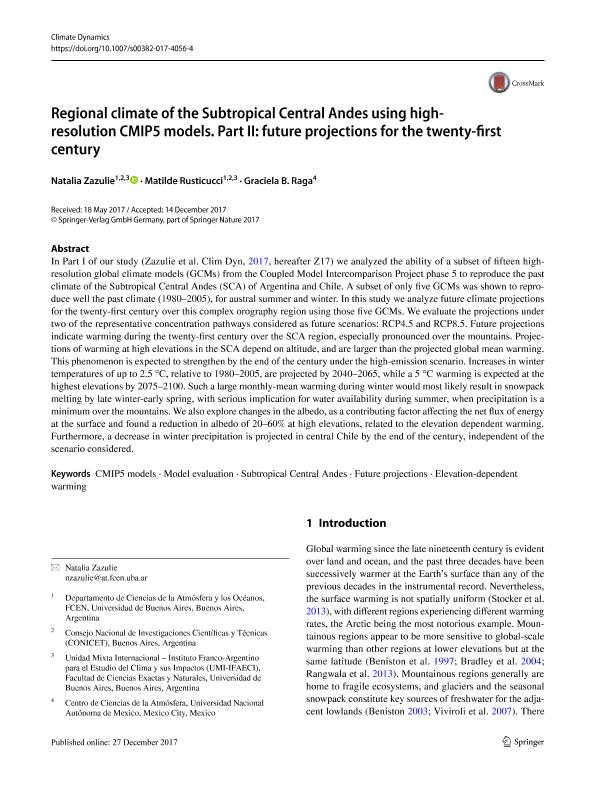Mostrar el registro sencillo del ítem
dc.contributor.author
Zazulie, Natalia

dc.contributor.author
Rusticucci, Matilde Monica

dc.contributor.author
Raga, Graciela B.
dc.date.available
2019-01-14T20:29:45Z
dc.date.issued
2018-10
dc.identifier.citation
Zazulie, Natalia; Rusticucci, Matilde Monica; Raga, Graciela B.; Regional climate of the Subtropical Central Andes using high-resolution CMIP5 models. Part II: future projections for the twenty-first century; Springer; Climate Dynamics; 51; 7-8; 10-2018; 2913-2925
dc.identifier.issn
0930-7575
dc.identifier.uri
http://hdl.handle.net/11336/68001
dc.description.abstract
In Part I of our study (Zazulie et al. Clim Dyn, 2017, hereafter Z17) we analyzed the ability of a subset of fifteen high-resolution global climate models (GCMs) from the Coupled Model Intercomparison Project phase 5 to reproduce the past climate of the Subtropical Central Andes (SCA) of Argentina and Chile. A subset of only five GCMs was shown to reproduce well the past climate (1980–2005), for austral summer and winter. In this study we analyze future climate projections for the twenty-first century over this complex orography region using those five GCMs. We evaluate the projections under two of the representative concentration pathways considered as future scenarios: RCP4.5 and RCP8.5. Future projections indicate warming during the twenty-first century over the SCA region, especially pronounced over the mountains. Projections of warming at high elevations in the SCA depend on altitude, and are larger than the projected global mean warming. This phenomenon is expected to strengthen by the end of the century under the high-emission scenario. Increases in winter temperatures of up to 2.5 °C, relative to 1980–2005, are projected by 2040–2065, while a 5 °C warming is expected at the highest elevations by 2075–2100. Such a large monthly-mean warming during winter would most likely result in snowpack melting by late winter-early spring, with serious implication for water availability during summer, when precipitation is a minimum over the mountains. We also explore changes in the albedo, as a contributing factor affecting the net flux of energy at the surface and found a reduction in albedo of 20–60% at high elevations, related to the elevation dependent warming. Furthermore, a decrease in winter precipitation is projected in central Chile by the end of the century, independent of the scenario considered.
dc.format
application/pdf
dc.language.iso
eng
dc.publisher
Springer

dc.rights
info:eu-repo/semantics/openAccess
dc.rights.uri
https://creativecommons.org/licenses/by-nc-sa/2.5/ar/
dc.subject
Cmip5 Models
dc.subject
Elevation-Dependent Warming
dc.subject
Future Projections
dc.subject
Model Evaluation
dc.subject
Subtropical Central Andes
dc.subject.classification
Meteorología y Ciencias Atmosféricas

dc.subject.classification
Ciencias de la Tierra y relacionadas con el Medio Ambiente

dc.subject.classification
CIENCIAS NATURALES Y EXACTAS

dc.title
Regional climate of the Subtropical Central Andes using high-resolution CMIP5 models. Part II: future projections for the twenty-first century
dc.type
info:eu-repo/semantics/article
dc.type
info:ar-repo/semantics/artículo
dc.type
info:eu-repo/semantics/publishedVersion
dc.date.updated
2019-01-14T18:53:26Z
dc.identifier.eissn
1432-0894
dc.journal.volume
51
dc.journal.number
7-8
dc.journal.pagination
2913-2925
dc.journal.pais
Alemania

dc.description.fil
Fil: Zazulie, Natalia. Consejo Nacional de Investigaciones Científicas y Técnicas; Argentina. Universidad de Buenos Aires. Facultad de Ciencias Exactas y Naturales. Departamento de Ciencias de la Atmósfera y los Océanos; Argentina
dc.description.fil
Fil: Rusticucci, Matilde Monica. Consejo Nacional de Investigaciones Científicas y Técnicas; Argentina. Universidad de Buenos Aires. Facultad de Ciencias Exactas y Naturales. Departamento de Ciencias de la Atmósfera y los Océanos; Argentina
dc.description.fil
Fil: Raga, Graciela B.. Universidad Nacional Autónoma de México; México
dc.journal.title
Climate Dynamics

dc.relation.alternativeid
info:eu-repo/semantics/altIdentifier/url/http://link.springer.com/10.1007/s00382-017-4056-4
dc.relation.alternativeid
info:eu-repo/semantics/altIdentifier/doi/http://dx.doi.org/10.1007/s00382-017-4056-4
Archivos asociados
